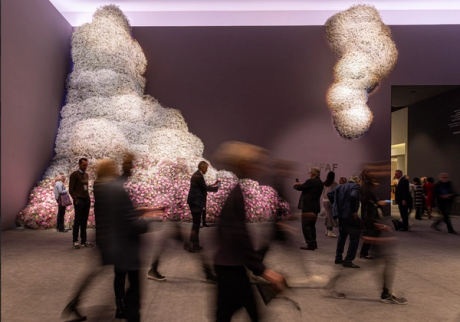
Old masters are a hard sell. “This is not a business for the faint-hearted. Or those in a hurry,” said Carlo Milano, the founder of London-based Callisto Fine Arts gallery, which opened in 2012.
Speaking last week at the opening of the 36th edition of Tefaf Maastricht, where Milano is exhibiting for the first time, in the Showcase section for galleries under ten, the dealer said “the mood was good “, although sales proved elusive on opening day (prices range from €7,500 to €175,000). Unlike contemporary art fairs, pre-sales are generally frowned upon at Tefaf.
“Some of my stuff took eight years to sell, but what’s eight years when you’re dealing with 500 years of history?” Milan added.
Another newcomer to the fair, Will Elliott of Elliott Fine Art, had sold three works in the early hours, including a photo of a bride from Bethlehem, by 19th-century Belgian painter Albrecht de Vriendt, which went up for auction. €120,000 to an American museum. He noted how institutions “seek to diversify their collections” by acquiring works by non-white sitters. “This sector of the market is much more present than it was two or three years ago,” Elliott said.
The change is slowly starting to happen to private buyers as well, according to some dealers. “Typically, the Old Masters collector is middle-aged, male, European. We’re starting to see a new generation, [who are] younger and with a different approach,” said Milano. “The type of collector that focuses on a specific school or artist is replaced by a new type: younger collectors who love the image and the story it tells.” This year, the Frick Museum invited 15 patrons under the age of 40 to the fair to encourage them to collect. Other museums present included the Musée d’Orsay, the Uffizi Galleries and the Minneapolis Institute of Art.
Veteran British dealer Nicholas Hall has noted how a growing number of elusive crossover collectors are being influenced by fashion designers such as Jonathan Anderson, Raf Simons and Vivienne Westwood, all of whom appropriated Old Master designs. Non-mainstream collectors, he added, are attracted to “strange subjects”, such as Hieronymus Bosch’s fantasy landscapes, skulls and witches, as well as “modernist still lifes” – especially Dutch images. and 17th century Spanish paintings – portraits that are “direct and thought provoking” and works by “very great names: Leonardo, Rembrandt etc”.
On Tefaf’s opening day, Hall reported selling a work by German Baroque painter Johann Carl Loth for “less than $500,000” to a European collector who, along with those on the US East Coast, remains the main driver of the old. main market.
Hall said he had tried to give a “more contemporary touch” to his presentation at the fair this year, although he added that while “old master images look great with contemporary and modern works, they do not thrive in a white cube”. In 2018 Hall collaborated with contemporary dealer David Zwirner on an exhibition titled Endless Enigma: Eight Centuries of Fantastic Art. Among the works Hall sold were a late Titian, to a contemporary buyer, as well as several medieval sculptures and a drawing by Goya. Future collaborations are in preparation. Hall would appear in good company. Last week the FinancialTimes reported that the contemporary Saatchi Yates galley is launching an Old Masters division.
There are ways, of course, to make new discoveries in ancient art. At Tefaf, British dealer Stuart Lochhead is exhibiting the works of two 19th-century sculptors, Félicie de Fauveau and Charlotte Besnard, two female artists “who have long been denied in the canon of art history”, according to the gallery. Lochhead noted that museums are “particularly interested in filling gaps in their collections”, while emphasizing that “an artist must be a good artist above all else”. De Fauveau’s marble portrait of King Henry V sold on the second day of the fair to an American institution, for “about $170,000”.
The supply of the best works is the perennial problem of Old Master dealers and big sales were not very present at the fair. One of the biggest sales reported on opening day, at the Lochhead stand, was a sculpture by Barthélemy Prieur, lion devouring a deerwhich sold for around £1.4million.
Although considerable by most people’s standards, the sum pales in comparison to the prices achieved for contemporary art. Indeed, in 2021, European Old Masters accounted for just 4% of fine art auctions, a figure dwarfed by the 45% share claimed by post-war and contemporary art.
Several dealers have pointed out that the comparison is questionable, given that the type of collector involved in the contemporary art market is more concerned with investment than “the values of beauty, quality and rarity”, as it is put. the Italian merchant Antonacci Lapiccirella. Within two days of the salon opening, she sold Giacomo Balla The four Seasons (1940) to a European private collector for approximately 1 million euros.
From a public perspective, “there is no shortage of interest in Old Master paintings,” said British dealer Charles Beddington. Indeed, just look at the fact that the Vermeer Exhibition at the Rijksmuseum sold out almost immediately, while there are regular queues to enter the Prado in Madrid or the Louvre in Paris.
Over time, dealers hope this interest will trickle down to the market. “I think there’s a growing feeling that old master paintings are undervalued compared to almost everything else, not just contemporary art but also sculpture and drawings,” Beddington said.
